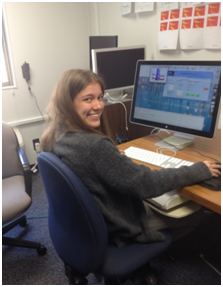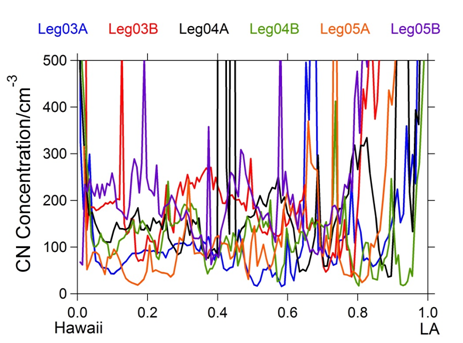MAGIC: An Interns Take
Published: 26 March 2014
Editor’s note: Ernie Lewis, principal investigator for the Marine ARM GPCI Investigations of Clouds (MAGIC) field campaign, sent this update.
Two weeks ago, I was at the Atmospheric System Research (ASR) Science Team Meeting and chaired a well-attended session on MAGIC. I gave a summary of MAGIC status and news and presented a few results on aerosol measurements taken during MAGIC. There were seven other presentations, including two from graduate students Xiaoli Zhou from McGill University in Montreal and Trevor Ferguson from University of Utah. Xiaoli and Courtney Laughlin, a graduate student from Penn State, won awards for their posters featuring MAGIC data!

It’s just over halfway through my internship here at BNL. In some ways it feels like I’ve been here for much longer, and in others, it feels like I just started! For the first half of my time here, I helped Ernie analyze MAGIC data. The first step in this process was to familiarize myself with IGOR, a programming language. I had absolutely no programming experience prior to this, so it seemed a bit daunting at first. However, after reading the manual a bit, enlisting help from Ty (another intern), and a lot of trial and error, I had some success. I wrote programs to average particle concentration values from the Condensation Particle Counter (CPC) and Ultra High Sensitivity Aerosol Spectrometer (UHSAS) for various time intervals (1 minute, 10 minutes, and 1 hour). I also found the average particle diameter values from UHSAS data.
There were a lot of spikes in the concentration data for both the CPC and UHSAS. Averaging over an hour smoothed out these spikes, but sometimes the UHSAS concentration would still be higher than the CPC concentration. This is concerning because the CPC should count all particles with diameters greater than 10 nm, while the UHSAS counts particles with diameters greater than 55 nm, so the CPC counts should always be higher. In the future, data from another instrument called the Particle Soot Absorption Photometer (PSAP) will be analyzed to see whether the spikes correspond with ship exhaust plumes. The PSAP traps particles on a filter and records the change in optical transmittance throughout time. This additional information should help identify the source of the spikes.

An example of CPC concentrations averaged over an hour for several legs is shown here. A leg is one trip across the Pacific: “A” legs are from LA to Hawaii, and “B” legs are from Hawaii to LA. Therefore, the graph contains data from three round trips. Concentrations are in particles per cubic centimeter (about half the volume of a sugar cube). Most concentrations fall between 100 and 300 particles per cubic centimeter. These are extremely low values, signifying that clean air is being sampled. For comparison, concentrations in a city can be in the thousands per cubic centimeter. We found no strong geographical patterns over the open ocean and a lot of variability between legs.
I also graphed size distributions from the UHSAS, which gave us an idea of what size particles were prevalent during the various legs. I found working with actual data much more rewarding than the programming aspect. What I have learned will be valuable for any future programming and data analysis, regardless of whether I go into atmospheric science or another field. I have now moved on from MAGIC, but it has been a great experience and I’m looking forward to the next month and a half at BNL!
Anastasia has been great to work with, and I appreciate all her help on analyzing the data and making graphs. I’m trying to convince her that she wants to go to graduate school in atmospheric chemistry—we’ll see if I’m successful!
As I mentioned in the last update, I’m organizing the First MAGIC Science Workshop, which will be held here at BNL in May. Busy, busy!
Ernie Lewis
The ARM Climate Research Facility is a DOE Office of Science user facility. The ARM Facility is operated by nine DOE national laboratories, including .
Keep up with the Atmospheric Observer
Updates on ARM news, events, and opportunities delivered to your inbox
ARM User Profile
ARM welcomes users from all institutions and nations. A free ARM user account is needed to access ARM data.


















